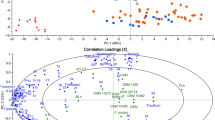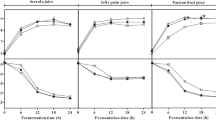Abstract
Water lettuce (Pistia stratiotes) is one of the most well-known aquatic weeds as it causes problems in watercourses all over the world. This invasive species is fast-growing and thus has the potential for its use in preparing growth medium of microorganisms. Toward it, the pretreatment and enzymatic saccharification are positively the decisive processes. But there are other crucial processes, which are usually ignored by researchers. To the best of my knowledge, this presented work is the first time discovering that the juice obtained from water lettuce is valuable. Except for sterilization, no treatment is needed for the water lettuce’s juice and it can be directly served for cell growth. For Escherichia coli, Saccharomyces cerevisiae, Pichia pastoris, Bacillus subtilis, Lactococcus Lactis, Lactobacillus rhamnosus, and Lactobacillus plantarum, the cell density in the broth of water lettuce’s juice as the only carbon source is 10–60% higher than that in LB, YPD, BHI, M17, MRS. We then examined the production of microbial lipid by YM prepared in the juice of water lettuce. In comparison to commercial medium YM broth, the YM with juice caused 84% increase in the production of microbial lipid. A simple process of collecting juice notably increased productivity.
Similar content being viewed by others
References
Menon, V. and M. Rao (2012) Trends in bioconversion of lignocellulose: biofuels, platform chemicals & biorefinery concept. Progress in Energy and Combustion Science 38: 522–50.
Phitsuwan, P., K. Sakka, and K. Ratanakhanokchai (2013) Improvement of lignocellulosic biomass in planta: a review of feedstocks, biomass recalcitrance, and strategic manipulation of ideal plants designed for ethanol production and processability. Biomass and Bioenergy 58: 390–405.
Eklund, R. and G. Zacchi (1995) Simultaneous saccharification and fermentation of steam-pretreated willow. Enzyme and Microbial Technology 17: 255–9.
Sreenath, H. K., R. G. Koegel, A. B. Moldes, T. W. Jeffries, and R. J. Straub (2001) Ethanol production from alfalfa fiber fractions by saccharification and fermentation. Process Biochemistry 36: 1199–204.
Martin, C., M. Galbe, C. F. Wahlbom, B. Hahn-Hägerdal, and L. J. Jönsson (2002) Ethanol production from enzymatic hydrolysates of sugarcane bagasse using recombinant xylose-utilising Saccharomyces cerevisiae. Enzyme and Microbial Technology 31: 274–82.
Mishima, D., M. Kuniki, K. Sei, S. Soda, M. Ike, and M. Fujita (2008) Ethanol production from candidate energy crops: water hyacinth (Eichhornia crassipes) and water lettuce (Pistia stratiotes L.). Bioresource Technology 99: 2495–500.
Chen, K.-Y., Y. Zheng, and Y.-S. Cheng (2015) Integrated alkali pretreatment and preservation of wet lettuce (Pistia stratiotes) by lactic acid bacteria for fermentable sugar production. Biomass and Bioenergy 81: 249–55.
Day, M. (2012) Pistia stratiotes L.-water lettuce. Biological Control of Weeds in Australia CSIRO Publishing, Collingwood, Victoria. 2012: 472–6.
Wilkie, A. C. and J. M. Evans (2010) Aquatic plants: an opportunity feedstock in the age of bioenergy. Biofuels 1: 311–21.
Anderson, L. W. (2003) A review of aquatic weed biology and management research conducted by the United States Department of Agriculture—Agricultural Research Service. Pest Management Science 59: 801–13.
Alvira, P., E. Tomás-Pejó, M. Ballesteros, and M. Negro (2010) Pretreatment technologies for an efficient bioethanol production process based on enzymatic hydrolysis: a review. Bioresource Technology 101: 4851–61.
Lin, Y. and S. Tanaka (2006) Ethanol fermentation from biomass resources: current state and prospects. Applied Microbiology and Biotechnology 69: 627–42.
Cereghino, J. L. and J. M. Cregg (2000) Heterologous protein expression in the methylotrophic yeast Pichia pastoris. FEMS Microbiology Reviews 24: 45–66.
Kunst, F., N. Ogasawara, I. Moszer, A. Albertini, G. Alloni, V. Azevedo, et al. (1997) The complete genome sequence of the gram-positive bacterium Bacillus subtilis. Nature 390: 249–56.
Braat, H., P. Rottiers, D. W. Hommes, N. Huyghebaert, E. Remaut, J. P. Remon, et al. (2006) A phase I trial with transgenic bacteria expressing interleukin-10 in Crohn’s disease. Clinical Gastroenterology and Hepatology 4: 754–9.
Näse, L., K. Hatakka, E. Savilahti, M. Saxelin, A. Pönkä, T. Poussa, et al. (2001) Effect of long-term consumption of a probiotic bacterium, Lactobacillus rhamnosus GG, in milk on dental caries and caries risk in children. Caries Research 35: 412–20.
Reid, G., D. Charbonneau, J. Erb, B. Kochanowski, D. Beuerman, R. Poehner, et al. (2003) Oral use of Lactobacillus rhamnosus GR-1 and L. fermentum RC-14 significantly alters vaginal flora: randomized, placebo-controlled trial in 64 healthy women. FEMS Immunology & Medical Microbiology 35: 131–4.
Kleerebezem, M., J. Boekhorst, R. van Kranenburg, D. Molenaar, O. P. Kuipers, R. Leer, et al. (2003) Complete genome sequence of Lactobacillus plantarum WCFS1. Proceedings of the National Academy of Sciences 100: 1990–5.
Yen, H.-W., Y.-C. Yang, and Y.-H. Yu (2012) Using crude glycerol and thin stillage for the production of microbial lipids through the cultivation of Rhodotorula glutinis. Journal of Bioscience and Bioengineering 114: 453–6.
Noble, J. E. and M. J. Bailey (2009) Quantitation of protein. Methods in Enzymology 463: 73–95.
Sun, S.-W., Y.-C. Lin, Y.-M. Weng, and M.-J. Chen (2006) Efficiency improvements on ninhydrin method for amino acid quantification. Journal of Food Composition and Analysis 19: 112–7.
González-García, Y., L. M. Rábago-Panduro, T. French, D. I. Camacho-Córdova, P. Gutiérrez-González, and J. Córdova (2017) High lipids accumulation in Rhodosporidium toruloides by applying single and multiple nutrients limitation in a simple chemically defined medium. Annals of Microbiology 67: 519–27.
Jacob, S. and R. Banerjee (2016) Modeling and optimization of anaerobic codigestion of potato waste and aquatic weed by response surface methodology and artificial neural network coupled genetic algorithm. Bioresource Technology 214: 386–95.
Borrero, J., Y. Chen, G. M. Dunny, and Y. N. Kaznessis (2014) Modified lactic acid bacteria detect and inhibit multiresistant enterococci. ACS Synthetic Biology. 4: 299–306.
Acknowledgments
The authors acknowledge Dr. Jun-Yi Leu at Academia Sinica for the gift of S. cerevisiae R1158, Prof. Cheng-Kang Lee at National Taiwan University of Science and Technology for L. lactis MG1363, Prof. Ai-Yu Wang at National Taiwan University for P. pastoris X-33, Prof. Shiuh-Bin Fang at Taipei Medical University for L. rhamnosus GG and L. plantarum, and Prof. Yaw-Nan Chang in Formosa University for Rhodotorula glutinis.
The authors acknowledge Prof. Gary M. Dunny and Prof. Yiannis Kaznessis at the University of Minnesota for the gift of E. faecalis OG1RF and L. lactis MG1363 (pBK1:Bac), respectively.
The authors acknowledge Prof. Cheng-Che Hsu at National Taiwan University for the use of HPLC.
This work was supported by grants (MOST 107-2221-E-027-037 -) from the Ministry of Science and Technology, R.O.C.
Author information
Authors and Affiliations
Corresponding author
Additional information
Publisher’s Note
Springer Nature remains neutral with regard to jurisdictional claims in published maps and institutional affiliations.
Rights and permissions
About this article
Cite this article
Lien, YH., Liu, FY., Chen, JN. et al. Using the Juice of Water Lettuce (Pistia stratiotes) as Culture Medium to Increase the Cell Density and the Production of Microbial Lipid. Biotechnol Bioproc E 24, 395–400 (2019). https://doi.org/10.1007/s12257-018-0404-4
Received:
Revised:
Accepted:
Published:
Issue Date:
DOI: https://doi.org/10.1007/s12257-018-0404-4




